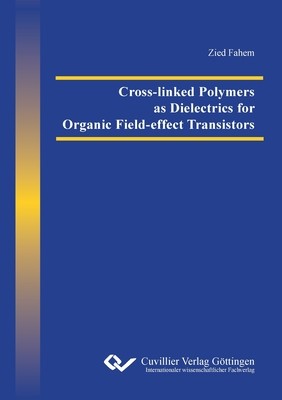
- We will send in 10–14 business days.
- Author: Zied Fahem
- Publisher: Cuvillier
- ISBN-10: 3954045613
- ISBN-13: 9783954045617
- Format: 14.8 x 21 x 0.6 cm, minkšti viršeliai
- Language: English
- SAVE -10% with code: EXTRA
Cross-linked Polymers as Dielectrics for Organic Field-effect Transistors (e-book) (used book) | bookbook.eu
Reviews
Description
Organic electronics are getting more and more interest from industrial companies and research groups in the last years since they enable many new applications, which could not be realized by inorganic materials [1{7]. Flexible displays [1], large-area sensors [1], light-emitting large surfaces [8], printable radio-frequency identification tags (RFID) for packaging or logistic industry [2] and many other systems which require exible, large area and low-cost electronic devices are now developed for the near future or even already commercialized. Organic light-emitting-diode (OLED) displays, for example, are now implemented in portable devices and have higher performance than the traditional LCD displays [9]. OLED displays are self illuminating and do not need back lightening, therefore they have higher brightness, contrast and viewing angle in comparison to LCD displays [9]. Many electronic devices producers implemented OLED displays in their high-end smartphones and SLR cameras [10], and recently LG (a Korean company) introduced a 55-inch OLED television [11]. Large-area solar cells based on organic materials have also found their way to commercialization [12]. All of these innovations were only possible after the introduction of organic conductors and semiconductors. Organic (semi)-conductors have the advantage of their low-cost processing technologies (e.g. printing or spray-coating). However, they have lower electrical conductivity, free charge carriers mobility [13] and packaging density than their inorganic counterparts. Therefore they are normally used in lowcost and low-performance applications, except in the case of OLED where they have clear advantages compared with other technologies. In order to produce fully exible devices, elementary devices for electronic circuits (e.g. transistors and diodes) need to be made with exible materials. The performance of these devices needs to be enhanced and their fabrication processes should be optimized to ensure their c
EXTRA 10 % discount with code: EXTRA
The promotion ends in 21d.03:46:28
The discount code is valid when purchasing from 10 €. Discounts do not stack.
- Author: Zied Fahem
- Publisher: Cuvillier
- ISBN-10: 3954045613
- ISBN-13: 9783954045617
- Format: 14.8 x 21 x 0.6 cm, minkšti viršeliai
- Language: English English
Organic electronics are getting more and more interest from industrial companies and research groups in the last years since they enable many new applications, which could not be realized by inorganic materials [1{7]. Flexible displays [1], large-area sensors [1], light-emitting large surfaces [8], printable radio-frequency identification tags (RFID) for packaging or logistic industry [2] and many other systems which require exible, large area and low-cost electronic devices are now developed for the near future or even already commercialized. Organic light-emitting-diode (OLED) displays, for example, are now implemented in portable devices and have higher performance than the traditional LCD displays [9]. OLED displays are self illuminating and do not need back lightening, therefore they have higher brightness, contrast and viewing angle in comparison to LCD displays [9]. Many electronic devices producers implemented OLED displays in their high-end smartphones and SLR cameras [10], and recently LG (a Korean company) introduced a 55-inch OLED television [11]. Large-area solar cells based on organic materials have also found their way to commercialization [12]. All of these innovations were only possible after the introduction of organic conductors and semiconductors. Organic (semi)-conductors have the advantage of their low-cost processing technologies (e.g. printing or spray-coating). However, they have lower electrical conductivity, free charge carriers mobility [13] and packaging density than their inorganic counterparts. Therefore they are normally used in lowcost and low-performance applications, except in the case of OLED where they have clear advantages compared with other technologies. In order to produce fully exible devices, elementary devices for electronic circuits (e.g. transistors and diodes) need to be made with exible materials. The performance of these devices needs to be enhanced and their fabrication processes should be optimized to ensure their c


Reviews